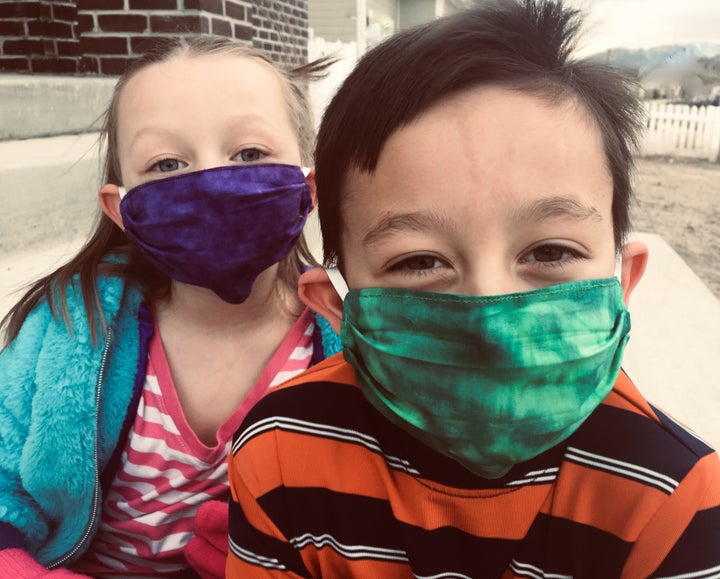
When it comes to mask-wearing, parents generally say their kids fall into one of two groups: the my-kid-wears-one-without-much-complaint set, or the my-kid-absolutely-refuses contingent.
But what if there is a third option — the we-just-haven’t-found-the-right-mask-yet group?
Because much like you wouldn’t buy one pair of shoes for your kid and declare shoe-wearing a nonstarter if he or she complained, experts say you shouldn’t write off masks for reluctant kiddos until you’ve taken some time to try and find the right one. Which is tricky, of course, because until a few months ago, very few of us had any experience with buying or making masks.
So we asked a few experts to share what parents should be looking for. Here’s what they had to say:
The mask should snugly cover your kid’s mouth and nose.
The Centers for Disease Control and Prevention says that kids ages 2 and up should wear a cloth face covering when they’re in public settings where it is hard to practice social distancing. And that mask should cover your child’s nose and mouth, the CDC says. You shouldn’t have to yank it down or pull it up to cover both at the same time.
Also critical? Make sure it’s snug and secure.
“A mask fits properly if there aren’t big gaps between the skin and the mask,” said Dr. Niket Sonpal, a New York-based internist and gastroenterologist and adjunct professor at Touro College. “If a mask is too big, while it is still better than nothing, air can circulate through one of the crevices.”
Ear loop vs. tie? Fabric thickness? These things matter.
Some kids are into masks that loop over the ears; others prefer ones with ties. Some kids might be able to handle a thicker mask (which confers a bit more protection); others won’t. Kids can be really sensitive to textures, too, said Dr. Hailey Nelson, a complex care pediatrician with Valley Children’s Healthcare in California.
For example, I’ve had some success in my own family with a relatively thin, stretchy “buff” — although Sonpal emphasized that heftier cotton is more effective in preventing the spread of the coronavirus.
“Comfort is a concern, I understand, and children [younger] than 2 have smaller airways, so it is harder for them to breathe through the mask,” he said. “Take these things into consideration.”
“Try to figure out that right fit for your child’s face, so that it is kind of snug but not pulling on their ears or bothering them,” echoed Nelson, adding that if the mask is loose, your kid will definitely mess with it more.
One tip: don’t just ask your kiddo if a given mask is comfortable because they’ll probably say no. Instead, spend some time watching them in it, being really mindful of some of those common fit and comfort issues.
Also, Nelson noted, since some schools are mulling having kids wear masks in the fall, parents are probably going to want to have at least five, plus a few extras on hand. It could take some trial and error to find a good fit, and many mask vendors are experiencing delays, so it is not a bad idea to plan ahead and make sure you’re stocked up.
Practice, practice, practice.
“Wearing a mask is a skill, and it’s a skill that we have to learn,” Nelson said. Start by having your kid wear the mask at home, if you haven’t already, so that the first (or first-ish) times they’re wearing it aren’t when they’re out in public and the stakes are high.
“There are ways you can do this and make it fun,” she said. Try putting a mask on your kid’s favorite stuffed animal (or a bunch of them!) or get them involved in buying or making their mask, so they feel like they have some control over the process.
No matter their age, be sure you’re also talking to them about why they’re wearing the mask. Kids like to help. Empower them (in a developmentally appropriate way) to understand the role they’re playing in keeping themselves and others healthy. (Here are a few more tips on getting kids to actually keep masks on.)
Make sure you’re modeling good mask-wearing yourself.
If you’re not dutifully wearing your mask when you head outside with your kiddo, there’s really no reason to expect them to take to it. Make sure you’re masked up when you’re in settings where you can’t socially distance. And be enthusiastic about it, Nelson urged.
“That can go a long way to set the tone and expectation,” she said.
Also, it’s OK to talk to your kid about adults you see in public who aren’t wearing masks themselves. Just explain that it’s what you’re doing as a family to keep yourselves healthy and that your family’s rules are the ones your kid should be following.
And remember, some level of mask-wearing is probably better than nothing.
“Anything that your child will tolerate is better than nothing at all,” Sonpal said — though he emphasized you really want to communicate how important it is for them to wear a mask, try not to touch their face, wash their hands, and maintain social distance.
Although mask-wearing has been framed as a “debate” in our country, experts say it is a simple step we can collectively take to try and limit the spread of COVID-19.
“This is not a political issue; this is a public health issue,” Sonpal said, adding that “if we all do our part in covering our nose and mouth, we can lower the infection rates.”